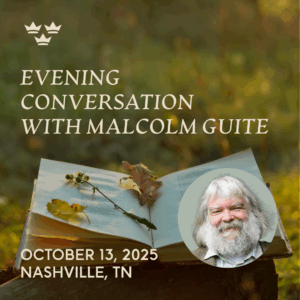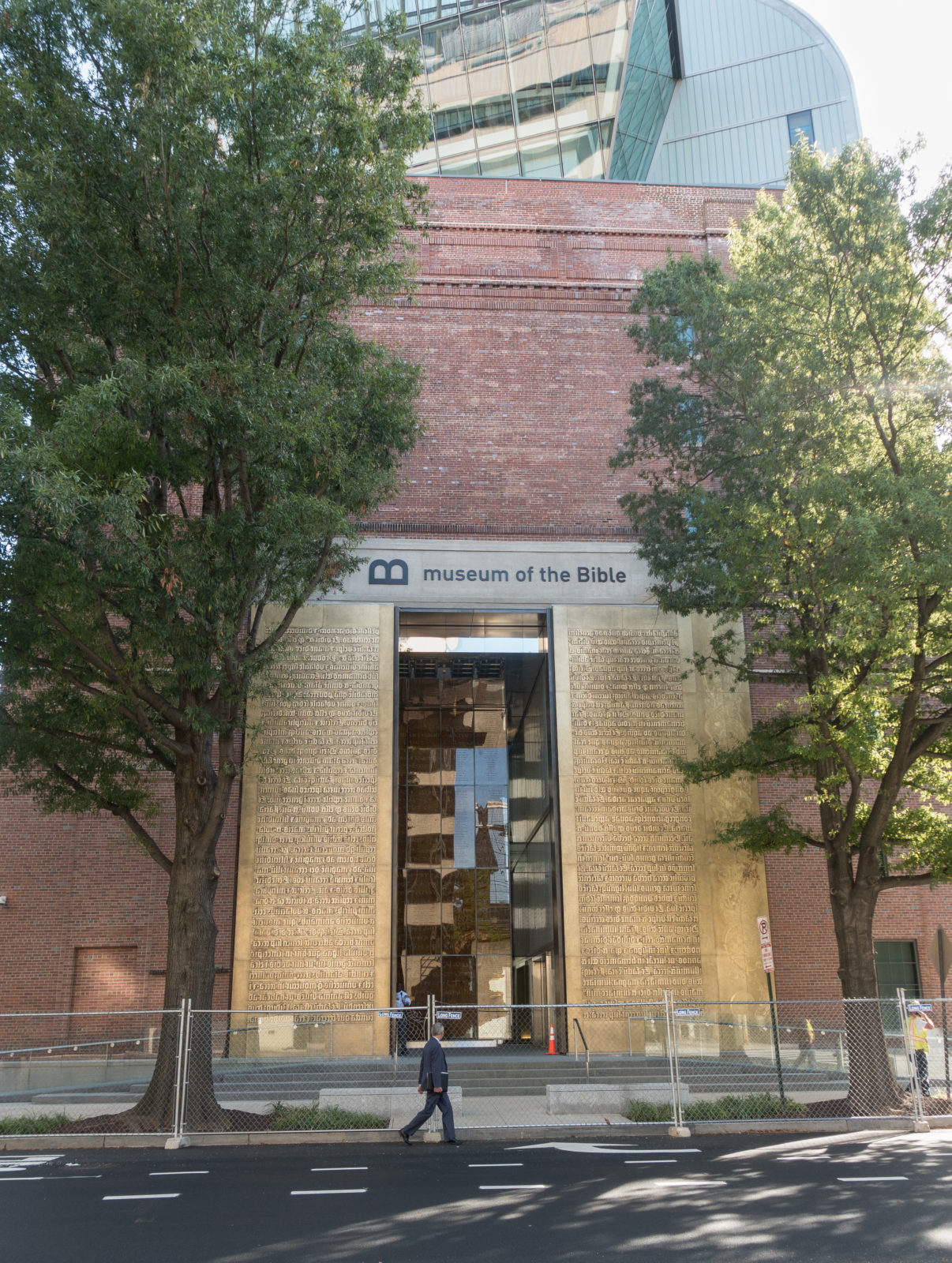Diana Muir Applebaum’s essay, “Who’s Afraid of the Museum of the Bible?,” is informative, skillfully argued, fair-minded, and leavened by wit and elegance. It is also much needed, since the museum has come under harsh assault from a variety of sources.
Before addressing the nature of that assault, I’d like to register very briefly my own favorable impressions of the museum, which I visited on December 30 with my daughter and some family friends. From the very first sight that greets one’s eyes—the two 40-foot-high bronze panels framing the entrance, bearing text from Genesis 1 on replicas of plates from the Gutenberg Bible, followed in the vestibule by a display of Psalm 19 on a papyrus leaf that dates back to the 3rd or 4th century CE—one is conscious of taking part in a highly singular experience.
In this six-floor building with its 430,000 square feet of exhibition space, visitors come face to face with the world of ancient Israel and Jesus of Nazareth rendered in works of art, more than 3,000 artifacts, and archeological discoveries laid out for inspection in display cases, immersive rooms, interactive exhibits, mini-theaters, and animated videos. Along the way, visitors will also learn the story, from ancient times to the present day, of the Bible’s impact on everything from art and culture, to human rights, to entertainment, to science and math, to, especially, the meaning of America.
Where Appelbaum’s essay is particularly helpful is in explaining for non-experts how the Museum of the Bible, by the standards used to judge any major museum, measures up quite well to, and in some respects better than, most. And this takes us immediately into the realm of the contentious, since, according to its critics, the museum is really not a proper museum at all—that is, an institution adhering to objective standards of scholarship and rational inquiry. Instead, in the words of one such critic, the Museum of the Bible is all about politics: self-consciously conceived as a “safe space for Christian nationalists,” it offers a transparent exercise in manipulative and shoddy theatrics, all designed to advance the “theological-political goals of its [evangelical] founders and patrons.”
The evidence rallied in support of this charge comes under various headings. For one thing, the museum has been taken to task for the sin of selectively biased omission of, for example, representative material from the world of Islam. Appelbaum, after noting evidence to the contrary, is properly dismissive: “while museums have a duty to describe accurately whatever they choose to exhibit, no museum is obligated to explore every topic related either directly or indirectly to its theme.” Or, as the museum’s president has put it, the Museum of the Bible “is not about the Quran, it’s more about the Bible.”
But has the museum described accurately what it chooses to exhibit? Not at all, say the critics: witness its reckless claims of antique provenance for manuscript fragments of dubious authenticity.
In fact, this is disputed territory—as the museum itself admirably stipulates. Placards installed under fragments previously thought to be contemporaneous with the Dead Sea Scrolls state scrupulously that “scholarly opinions of [the fragments’] authenticity remain divided. Scientific analysis of the ink and handwriting on these pieces continues.”
As for the underlying claim that the museum is a front for “evangelical propaganda” or “a safe space for Christian nationalists,” that was hardly my sense of it any more than it was Appelbaum’s. Nor was it the sense of National Geographic, whose writer testified that the museum (after some early missteps by its founders, long predating the museum’s opening and duly recounted by Applebaum) “abides by academic best practices.” Concerning the disputed manuscripts in particular, the same writer reports that in fact “the Museum of the Bible has supported the very work on the Dead Sea Scrolls that has uncovered evidence of forgery.” This, in a publication that no one will ever confuse with, say, Christianity Today or the Pentecostal magazine Charisma.
It was no doubt on these and similar grounds that Philip Kennicott, the Pulitzer Prize-winning art-and-architecture critic of the Washington Post, judged that “what [the Museum of the Bible] does well, it does as well as or better than any museum in the country.” Here, scholarship is taken seriously, and unpleasant facts—like the fact that in the 19th-century American debate over slavery, the Bible was invoked by both sides—are not whitewashed; the overall purpose is not propaganda but engagement with the Bible’s history and legacy.
To me, one standout example of this purpose at work was a display of stylized posters of key biblical characters on the walls outside the New Testament Theater. On the poster of Jesus, the text reads:
Jesus was called many things. His detractors questioned his authority to speak for God. His followers embraced him as God’s prophet or even the king for whom they had been waiting. The gospel writers report that Jesus called himself “the Son of Man.” To the ears of his contemporary Jews, he was invoking the end-time figure in the book of Daniel. In his vision, Daniel saw “one like the Son of Man, coming with the clouds of heaven” (Daniel 7:13-14). He would return to God’s suffering people and establish an “everlasting kingdom.”
Teacher or Blasphemer?
Healer or Magician?
King or Rebel?
Son of God or an Ordinary Man?“Who do people say that I am?” (Mark 8:27)
This hardly qualifies as in-your-face, fire-and-brimstone missionizing.
In short, anyone expecting to find a politicized museum dedicated to hot-button “culture-war” issues needs to look elsewhere. Unfortunately, as Applebaum is at pains to document, the National Mall already offers some distressing specimens of the type, if from a different side of the cultural spectrum entirely.
What explainsthe barbed attacks on a museum that by any impartial standard is one of the best in America? Applebaum gets at it when she writes:
[O]f making many superficial and easily rebutted complaints [about the museum] there has been no end—so many, in fact, that one begins to wonder whether these complaints are not themselves a cover for sheer prejudice against evangelical Christians, if not against a book that is still stubbornly held sacred by many millions, on the part of critics convinced that only a primitive and unenlightened mind could regard the Bible as anything more than a pastiche of stories and myths wholly uncorroborated in ancient or archeological sources.
Elaborating on this, I myself would point to a combination of contempt and fear regarding not just a certain type of evangelical Christianity but also toward religious faith in general. For some on the secular left, faith is at best tolerable, at worst an active threat. This is the starting proposition; much flows from it, including the conviction that faith, if taken too seriously, poses a danger to our rights, to the American constitutional order, and to science itself. As the Bible is a source of inspiration for the benighted, a museum dedicated to the Bible needs to be discredited. One cannot be too vigilant, after all.
Several things need to be said here, but perhaps the first is that we should not exaggerate. The attitude I’ve described, while quite real in certain quarters, is not as prevalent as some Christians have convinced themselves it is. Many non-believing liberals don’t actually feel their life’s calling is to bring down the Christian faith.
In this connection, one young evangelical Christian with whom I had coffee the other week told me something interesting about his interactions with fellow students at his prestigious (non-Christian) university: “I was prepared to face an enemy that didn’t exist.”
Having been conditioned to think that, as a believing Christian, his faith would come under relentless assault, this young man found instead, for the most part, a live-and-let live indifference. To his fellow students, Christianity was less a threat than an irrelevance. I (and others) might frankly wish for a more positive attitude than that, or at least one more openly curious; but that is a concern for another occasion.
Something else should be said as well: the conduct of some prominent evangelical leaders over the years—whether through failings in the realm of public morals, or through egregious instances of pandering to political power, or through ill-reasoned panic over the perceived loss of Christian influence in American society and culture—has contributed to the creation of a negative stereotype of the evangelical world in the minds of many Americans, including those not otherwise invested in unbelief.
But that is hardly the whole of it, not by a long shot. Another story needs to be told and heard, expressed and received. For millions upon millions of people, religious faith is not only not a threat to the Republic; to the contrary, it is a source of strength and attachment, indeed a bulwark of the larger national enterprise. On an individual and communal level, religious faith, lived among other ways through reverence for the Bible and the taking to heart of its message, deepens people’s commitment to and care for others, sparking innumerable selfless acts of charity and generosity.
That same Bible offers to many believers a wellspring of moral courage as well as comfort in a fallen world. It inspires them to reconcile broken relationships, dispense grace to those in need, and share kinship and mutual belonging with the stricken who live in shadow.
More than any book in history, the Bible has changed lives, and changed the world, for the better. It has long deserved a museum that tells its story in an honest, comprehensive, and compelling way. Now it finally has one.
Peter Wehner, a contributing opinion writer for the New York Times, is a senior fellow at the Ethics and Public Policy Center and director of the Faith Angle Forum.


